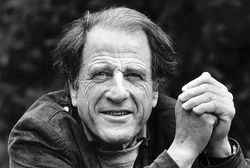Foss, Lukas
Biography
Born: August 15, 1922
Died: February 1, 2009, Manhattan, New York City, NY
Country: Berlin, Germany (emigrate U.S.A.1937)
Studies: Berlin; Tanglewood; Curtis Institute (1940)
Teachers: Julius Herford, Fritz Reiner, S. Koussevitsky, Paul Hindemith
The German-born American composer, conductor, pianist, and educator, Lukas Foss, began his musical studies in Berlin, where he studied piano and theory with Julius Goldstein. Goldstein introduced Foss to the music of Bach, Mozart, and L.v. Beethoven, which had a profound effect on Foss musical development. In 1933, Foss went to Paris where he studied piano with Lazare Lévy as well as composition with Noël Gallon, orchestration with Felix Wolfes, and flute with Louis Moyse. He remained in Paris until 1937, when he moved with his family to the USA, continuing his musical instruction at the Curtis Institute of Music in Philadelphia. In addition, he studied conducting with Serge Koussevitzky during the summers from 1939 to 1943 at the Berkshire Music Center. He also studied composition with Paul Hindemith as a special student at Yale from 1939 to 1940.
Lukas Foss began to compose at the age of 7 and was first published at 15. At the age of 22, he won the New York Music Critic's Award for his cantata Prairie, which was premiered by the Collegiate Chorale, under the direction of Robert Shaw. From 1944 to 1950 he served as the pianist of the Boston Symphony Orchestra. In 1945 he was the youngest composer ever to receive a Guggenheim fellowship. From 1950-1951 he was a fellow at the American Academy in Rome, and received a Fulbright grant for 1950-1952.
In February of 1953 Lukas Foss received an appointment as professor of music at the University of California at Los Angeles - succeeding Arnold Schoenberg - where he taught composition and conducting. While at UCLA, he founded the groundbreaking Improvisation Chamber Ensemble. He served from 1963 to 1970 as music director and conductor of the Buffalo Philharmonic Orchestra. In 1963, at the State University of New York at Buffalo, Foss founded, and became the director of, the Center for Creative and Performing Arts. In 1971, Foss became the conductor of the Brooklyn Philharmonic, a position which he held until 1990 when he was named Conductor-Laureate. In 1972, he was appointed conductor of the Kol Israel Orchestra of Jerusalem. In 1972-1973 he served as composer-in-residence at the Manhattan School of Music in New York, and from 1981 to 1986 was conductor of the Milwaukee Symphony.
Lukas Foss was a member of the American Academy of Arts and Letters, and in 1989-1990 served as composer in residence at the Tanglewood Music Center. He became professor of music at the School for the Arts at Boston University in 1991. He has also traveled widely, appearing as a guest conductor with many American and European Orchestras, and lecturing at many North American colleges and universities, including Harvard and Carnegie Mellon.
Lukas Foss had contributed profoundly to the circulation and appreciation of music of the 20th century. His compositions illustrate two main periods in his artistic development, separated by a middle, avant-garde phase. The works of his first period are predominantly neo-classic in style, and reflect his love of J.S. Bach and Igor Stravinsky. In the transitional period he fused elements of controlled improvisation and chance operations with 12-tone, and serialist techniques. Notable works of this period include the Baroque Variations for orchestra, and the chamber works Time Cycle (1960), Thirteen Ways of Looking at a Blackbird (1978), and Echoi (1963). His later period works, including the Renaissance Concerto (1990) for flute, embrace a wide variety of musical references, displaying a keen awareness of idioms and styles that span the history of western art music.[1]
Works for Percussion
Concerto for Solo Percussion and Large or Small Orchestra - Multiple Percussion; Orchestra
Curriculum Vitae with Time Bomb - Multiple Percussion; Accordion; With Tape
Echoi for Four Soloists - Multiple Percussion; Chamber Ensemble
Ni Bruit Ni Vitesse - Percussion Duo
Paradigm - Multiple Percussion; Chamber Ensemble
Percussion Quartet (Foss) - Percussion Quartet
References
